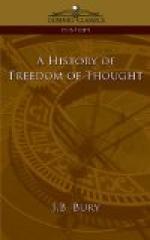Again, if every believer is convinced of the reality of miracles, every reasonable man is convinced of their cessation. Yet every age bears testimony to miracles, and the testimony seems no less respectable than that of the preceding generation. When did they cease? How was it that the generation which saw the last genuine miracles performed could not distinguish them from the impostures which followed? Had men so soon forgotten “the style of the divine artist”? The inference is that genuine and spurious miracles are indistinguishable. But the credulity or “softness of temper” among early believers was beneficial to the cause of truth and religion. “In modern times, a latent and even involuntary scepticism adheres to the most pious dispositions. Their
[166] admission of supernatural truths is much less an active consent than a cold and passive acquiescence. Accustomed long since to observe and to respect the invariable order of nature, our reason, or at least our imagination, is not sufficiently prepared to sustain the visible action of the Deity.”
Gibbon had not the advantage of the minute critical labours which in the following century were expended on his sources of information, but his masterly exposure of the conventional history of the early Church remains in many of its most important points perfectly valid to-day. I suspect that his artillery has produced more effect on intelligent minds in subsequent generations than the archery of Voltaire. For his book became indispensable as the great history of the Middle Ages; the most orthodox could not do without it; and the poison must have often worked.
We have seen how theological controversy in the first half of the eighteenth century had turned on the question whether the revealed religion was consistent and compatible with natural religion. The deistic attacks, on this line, were almost exhausted by the middle of the century, and the orthodox thought that they had been satisfactorily answered. But it was not enough to show that the revelation
[167] is reasonable; it was necessary to prove that it is real and rests on a solid historical basis. This was the question raised in an acute form by the criticisms of Hume and Middleton (1748) on miracles. The ablest answer was given by Paley in his Evidences of Christianity (1794), the only one of the apologies of that age which is still read, though it has ceased to have any value. Paley’s theology illustrates how orthodox opinions are coloured, unconsciously, by the spirit of the time. He proved (in his Natural Theology) the existence of God by the argument from design —without taking any account of the criticisms of Hume on that argument. Just as a watchmaker is inferred from a watch, so a divine workman is inferred from contrivances in nature. Paley takes his instances of such contrivance largely from the organs and constitution of the human body. His idea of God is that of an ingenious contriver dealing with rather obstinate material. Paley’s “God” (Mr. Leslie Stephen remarked) “has been civilized like man; he has become scientific and ingenious; he is superior to Watt or Priestley in devising mechanical and chemical contrivances, and is therefore made in the image of that generation of which Watt and Priestley were conspicuous lights.” When a God of this kind




